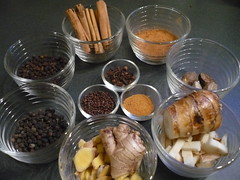
Click on picture to see series of photographs of spices used to make a powder fort.*
Seitan Bake part one includes a generic range of spices: cinnamon, cloves, ginger, long pepper, grains of paradise, and black pepper. These are spices discussed over and over in medieval recipes. I, myself, am not over fond of cinnamon and so tend to make my medieval spice mixtures ginger and pepper heavy. It would be correct to say that I used a powder fort mix in the seitan.
It would also be correct to say that many more (and less) well-researched people have tackled the vagueness that surrounds the contents and proportions of many medieval spice mixtures. I've linked to some of them below, and I would encourage anyone wanting to tackle the issue him or herself be not limited by the ideas of others or the few specific ingredient lists found in the existing manuscripts. Ultimately, you have to eat it. Ultimately, the powder fort of 15th c. France is not the powder fort of 14th c. England, and the powder fort of 14th c. London is not the powder fort of 14th c. York. Similar spices may have been used across all these places and eras, but it is just as valid to add a little something known in period that is not a part of that usual spice range. This is particularly noticeable in the powder douce recipes, which contain a splendid mess of possibilities.
Other people's ideas about the perfect combination of the mystery spice mixes mentioned in medieval cookery manuscripts: powder fine, powder forte, powder blanche, powder douce. Powder may also be spelled as poudre.
An article with a basic spice conversation and multiple recipes for Powders fine, douce, and forte:
http://web.archive.org/web/20080131160345/http://www.thorngrove.net/athenaeum/powder.htm
Other recipes for Powder douce:
http://cookalong.blogspot.com/2007/11/on-poudre-douce.html
http://www.practicallyedible.com/edible.nsf/pages/powderdouce
http://recipes.medievalcookery.com/douce.html
http://www.celtnet.org.uk/recipes/mediaeval/fetch-recipe.php?rid=medi-powder-douce
http://www.recipezaar.com/poudre-douce-powder-douce-361645
http://www.livinghistorylectures.com/Powder%20Douce.pdf
Also try: apple pie spice, chai spice blend
Others for Powder Forte:
http://www.practicallyedible.com/edible.nsf/pages/powderforte
http://recipes.medievalcookery.com/fort.html
http://www.livinghistorylectures.com/Powder%20Forte.pdf
http://www.celtnet.org.uk/recipes/mediaeval/fetch-recipe.php?rid=medi-powder-fort
Powder Fine:
http://www.practicallyedible.com/edible.nsf/pages/finepowder
http://recipes.medievalcookery.com/fine.html
Powder Blanch:
http://www.practicallyedible.com/edible.nsf/pages/powderblanch
http://www.celtnet.org.uk/recipes/mediaeval/fetch-recipe.php?rid=medi-blanche-powder
You know, I do think it is time for me to pack up my own blends of these spices just to save some time in prep--right now, I tend to measure them out individually, but it would be faster to mix the spices in the proportions I prefer.
*Use of this image is believed to be consistent with fair use as it is used in a reduced-size format, in a no-profit context, to link back to a series of publicly viewable photos which illustrate the subject matter of this educational post. Attribution for photo is found by clicking back to the photo series.



